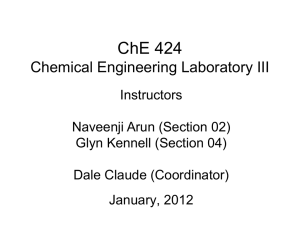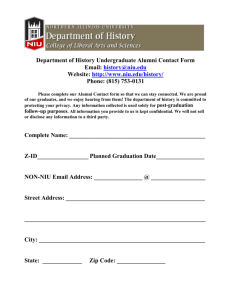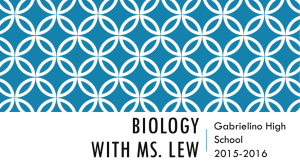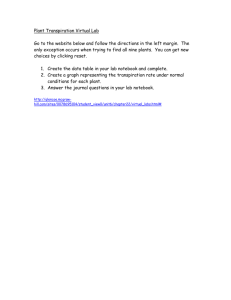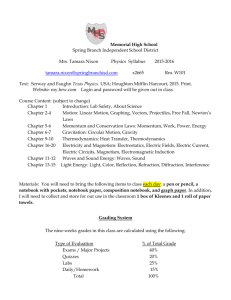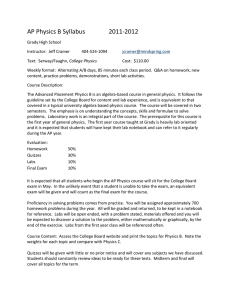Laboratory conference notes (ppt
advertisement
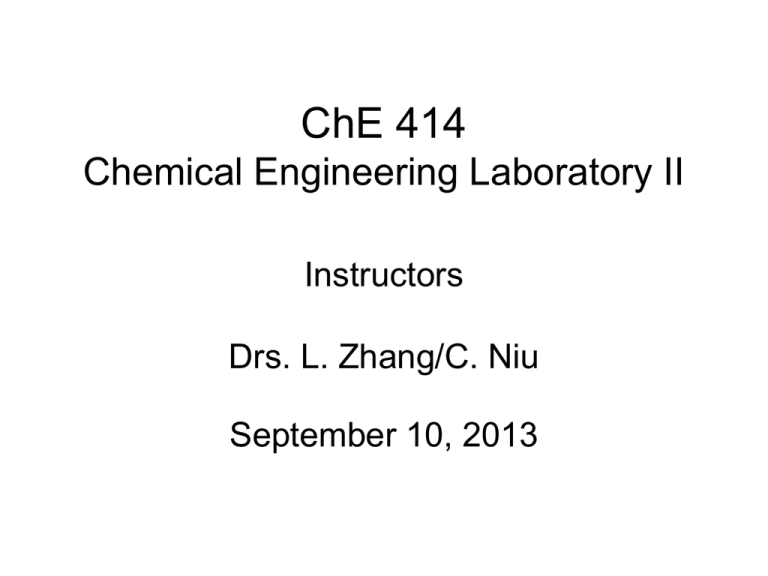
ChE 414 Chemical Engineering Laboratory II Instructors Drs. L. Zhang/C. Niu September 10, 2013 Contact info • Instructor: Dr. Lifeng Zhang – Engineering 1C122 – liz795@usask.ca; ph: 966-4799 • Instructor: Dr. C. Niu – Engineering 1C129 – catherine.niu@usask.ca; ph: 966-2174 Contact Info • Coordinator: Dale Claude – Engineering 1D43 – dale.claude@usask.ca; ph: 966-4707 • Technician: Kevin Carter – kjc901@mail.usask.ca; ph: 966-4707 Contact info • Demonstrator: Vahid Vasoughi – vav028@mail.usask.ca • Demonstrator: Sepideh Shankarami – Sepideh.Shankarami@usask.ca Course information • Website: http://engrwww.usask.ca/classes/CHE/414/ • Lab location: Engineering 1D25 • Lab time – Monday 14:30 – 17:30 – Tuesday 14:30 – 17:30 Text: - ChE 414.2 Laboratory Manual (available online on the course website) - S. Jeter, J. Donnell. (2004) Writing style and standards in undergraduate reports Office Hours: Dr. L. Zhang: open door/email, Rm: 1C122 Eng. Bldg. Dr. C. Niu: open door /email, Rm: 1C129 Eng. Bldg. What Labs ? • Fermentation: Kinetics of yeast growth • Filtration: Separation of calcium carbonate from water • Distillation: Continuous separation of methanol from water • Boiling and Condensing: Heat transfer • Fluidization: Pressure drop and heat transfer • Packed Column: Pressure drop and flooding Instructors for Labs Dr. L. Zhang: •Boiling and Condensing: Heat transfer •Fluidization: Pressure drop and heat transfer •Packed Column: Pressure drop and flooding Dr. C. Niu: •Fermentation: Kinetics of yeast growth •Filtration: Separation of calcium carbonate from water •Distillation: Continuous separation of methanol from water Formal report marked by instructors, memo by lab demonstrators. COURSE OBJECTIVES: Develop skills in - Equipment operation - Data recording - Analysis of the data using academic theory - Technical report writing in the selected typical Chem. Eng. processes Marking • • • • • Lab performance: (4X2.5%) Lab notebook: 10% Technical memos: (2X10%) Oral Presentation: 25% Formal report: 35% Overall mark: 100% No exam 90 - 100 80 - 89 70-79 Exceptional Excellent Good 60-69 50-59 Satisfactory Minimal Pass <50 Failure •The mark distribution is only approximate. •Final grades will be assigned at the discretion of the instructor subject to the University Council and College Regulations on Examinations. Plagiarism is DEFINITELY NOT acceptable! – Copy other people’s report – Citing without referencing the source Plagiarism results in 0 mark for the report Be aware of & Follow the new University of Saskatchewan Academic Honesty/Dishonesty definitions, rules and procedures www.usask.ca/honesty. Due Date and Overdue Penalty • Due date for the reports: - 2 weeks after the experiment date. - The date of submission is counted by the date on which the hard copies of your reports are handed in to and signed by Mr. Dale Claude. AND - Electronic copies of the reports must be sent to both Dale and Drs. Zhang/Niu by email on the same day for verification. - When submission on weekends, the date of submission of reports by email can be counted, however, the hardcopies of your reports must be handed in to Dale on the following Monday to avoid extra delay penalty. - 7 “free” late hand-in days for the whole course - Must indicate on your reports when use it to avoid late penalty. Due Date and Overdue Penalty Penalty - 0.5% of the full marks of this course per day (including weekends, and other statuary Holidays), will be deducted from the late reports. -Submissions including lab notebooks/reports will NOT be accepted after Dec. 4, 2013. Requirements • Lab performance • Write-ups: technical writing • Fundamentals of each lab Laboratory procedure (This slide is courtesy to J. Wiens’ ChE333 Conference Notes 2007) 2 weeks Lab performance Be prepared for: • • • • • • Objectives Theory / knowledge Design of experiment Parameters to be measured Apparatuses, procedures and principles Find out: what to learn Initiate the contact for the pre-lab help with the demonstrators & the lab coordinator Lab performance During the experiments: • • • • Follow the experimental procedures Record observations in Lab Notebook Test the validity of data and/or results Pay attention to SAFETY issues – personnel – equipment Write-ups / Reports • Technical memo • Presentation • Formal report • Lab notebook Write-ups / Reports One student is required to hand in – 2 technical memos – 1 oral presentation file (each group makes one) – 1 formal report – 1 lab notebook Write-ups / Reports No repetition in each group for – formal report – oral presentation file – technical memos Write-ups / Reports Tech. memos You Your partner Labs A and B Labs C and D Oral Lab C or A (work by the group) presentation Formal report Lab D Lab B Lab notebook Labs A,B,C,D Labs A,B,C,D In one group, you may label the 4 labs by A, B, C, and D in your own order. Each member of the group should keep the same order. Lab Notebook No sheets of paper Permanently bounded & recorded • Briefly outline the title, date performed, names of group members, objectives, apparatus, experimental conditions and procedures before labs Suggest making table for recording data • Record clearly all original observations, simple calculations of data, & graphs or tables showing salient conclusions from the experiments. • MUST be examined, dated and initialed by the TAs before leaving the laboratory Lab Notebook Refer to ChE 414 class website for RULES FOR LABORTORY NOTEBOOKS Submit the lab notebook at the end of the term (by Dec 4, 2013) for marking Technical Memorandum • Title and names: course number name (Your name and state the partner’s name) lab title prepared for (lab demonstrator’s name) date lab done date report due state if you use the free late days • Body of text: maximum two pages (doubled spaced) • Introduction concise introduction of the system used a brief statement of the objectives of the experiment a general description of the procedure followed Technical Memorandum • Results and Discussion discussion and comparison of all required results with values from literature major equations used, but not mixed with text in the same paragraph a brief table of results or major graphs attached to support the conclusions. • Conclusions and recommendations • Sign your memo on the last page below the text Formal Technical Report (double spaced) – – – – – – – – – – – – Title page and Table of Contents Abstract Table of contents, table of figures, table of tables Introduction Review of theory or literature Experimental Section: apparatus and procedure Results and Discussion Conclusions Recommendations Nomenclature References Appendices Formal Technical Report Title page • Course number • Name (Your name and state the partner’s name) • Lab title • Prepared for (instructor’s name) • Date lab done • Date report due • State if you use the free late days Table of contents (Double spaced, max 20 pages) Formal Technical Report Abstract • State briefly the purpose of the investigation • Describe briefly how the results are obtained • Give all required results in a concise and quantitative format if possible. • Use words, no tables, figures and equations • Normally no more than 250 words. Formal Technical Report Introduction • Include information on the subject of the investigation and its importance in industry; • Describe clearly the objectives of the lab; • Cite the references. Formal Technical Report Literature review or theory • Provide sufficient theoretical background to the particular experiments • Develop the equations or models to correlate your experimental data. Number the equations. detailed derivation placed in Appendix • Describe how to obtain the model parameters and predict the particular system • Cite the references Formal Technical Report Apparatus and Experimental Procedures • Specify the main apparatuses used make, model and use • Describe the procedures Highlight important experimental conditions • Give the names of quality of the materials. Make sure other people can repeat your work and obtain the same results if they follow your description. Formal Technical Report Results and Discussion • Present the significant experiment results required in the Lab Manual in words and graphs. • State the data treatment processes and the outcomes. • Discuss the results of experiments and model simulations or predictions. • Compare your results with that in literatures if available. • Logically discuss and lead to conclusions. Attention • Consistent format • The unit for every parameter in the equations has to be conformed. • Figures or Tables in the body of text – Titles of figures, axes, and tables – Briefly state the experimental conditions – Experimental data: represented by unique symbol for each group of data in figures – Modeling curves: different lines with legends – Show model significance when fitting models Cr uptake (mmol/g) 0.8 0.7 0.6 model predicting curve relative dev.: 5.1% model prediction when g =1 relative dev.: 11.5% error bar: 95% confidence interval w ithout NaCl addition 0.5 0.4 0.1M NaCl 0.3 0.1M NaCl 0.2 pH 2.0 0.1 0 0 2 4 6 8 10 Equilibrium Cr concentration (mM) Figure 1. Modeling the effect of IS on Cr uptakes 40±1 mg AWUS, 20±0.2 mL solution Formal Technical Report Conclusions and Recommendations • Conclusions should be summarized following the discussion. • Lists your suggestions on how we can improve the labs. Formal Technical Report Nomenclature • Completely lists the symbols that appear in your report, their definition and unit in a professional and consistent format. Refer to a published paper. Formal Technical Report References • Completely lists every reference cited, mentioned or used in the text of the report in a professional and consistent format. • Follows either the number order or the alphabetical order. Formal Technical Report Reference format examples In the text: ……Adams concluded that ……1. However, that conclusion may be suspicious because ……2 In the Reference section: References 1. Adams, A. B. title of publication. …… 2. Cook, H. M., Author #2, …… Ref: Industrial and Engineering Chemistry Research or in the text: It was concluded ( Adams, 2001) that ……. However, that conclusion may be suspicious (Davis and Volesky, 2001) because ……(Niu, et al., 2005) References Adams, A. B. year, title of publication, publisher, page (book) Davis, T. and B. Volesky, year, title of paper, journal name, volume, issue, pages (paper) Niu, C., M. Huang and B.Volesky, year …. Ref: Canadian Journal of Chemical Engineering Formal Technical Report Appendices • Raw data (neat with tables) • Calculated data • Sample calculation (using a set of data to show the steps of calculations) • Tables and Figures Appendices (Courtesy to Jason Wiens’ ChE333 Conference Notes 2007) • Raw & Calculated data in tables • Sample Calculations Descriptive title For example 1. Calculation of the volumetric flow rate of air through the absorption column Q Uo A Equation used Keep units m 2 Q 3.0 0.50m s Result with m3 Q 1.5 proper sig figs s Oral Presentation – Each group is required to deliver one oral presentation based on the lab they have performed. – The content of the presentation should include introduction of the lab, theories and/or principles, objectives of the lab, experimental procedures, data collection, data processing, results and discussion, conclusion and recommendation. – The duration of the presentation is 13 -15 minutes. – All the students in the same group will work collaboratively, and will be evaluated as a group. – All students must attend the group presentations and participate the grading. Irresponsible grading will lead to reduce of the overall marks. A good report/presentation • Careful measurements • Correct calculations • Understanding and use of the theory or models • Logical discussions • Correct conclusions Organized Clarity No grammar & typographical errors • References • Oral presentation Important dates • September 16: First day of labs • Sept 18: Last day for making changes in registration for T1 classes • Oct 14 (Mon): Thanksgiving – Univ. Closed • Nov 11 (Mon): Remembrance Day • Nov 15: Last day to drop T1 Fall Term classes without academic penalty • Dec 4: Last day of classes Last day to hand in laboratory reports and laboratory notebooks for marking Assessment data will be collected from this course for the program indicator – Individual and Team Work Rubric will be posted on the class website if data are collected. -Evaluate “as a team member” -Evaluate “as a leader”. Samples are to be randomly chosen from students who will submit a formal report for a lab. Summary • Academic theory understanding • Lab performance • WRITEUPS Successful!
